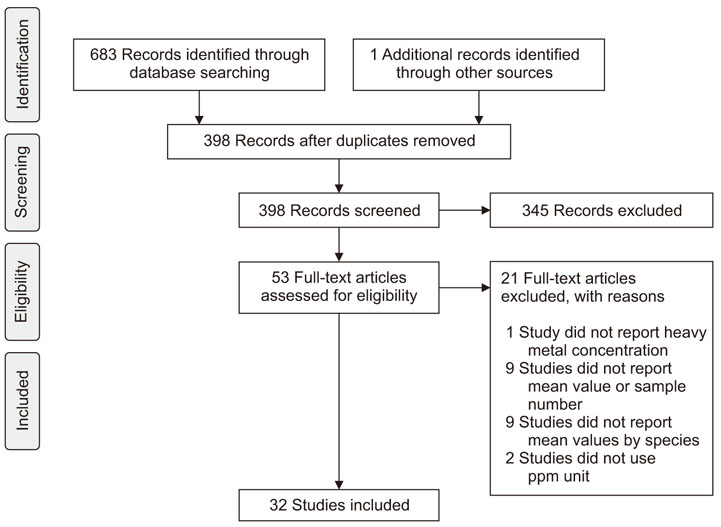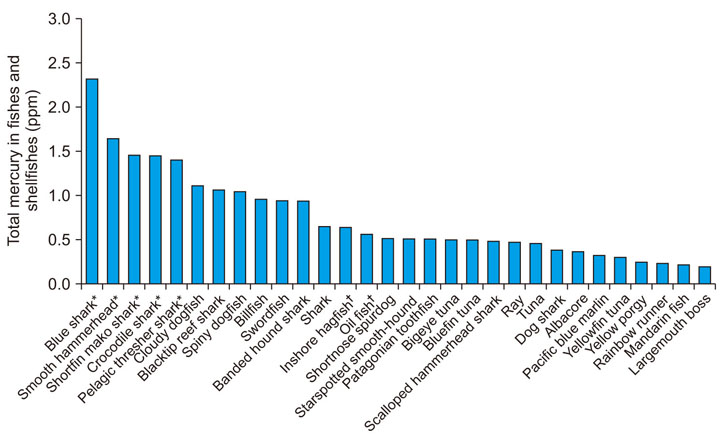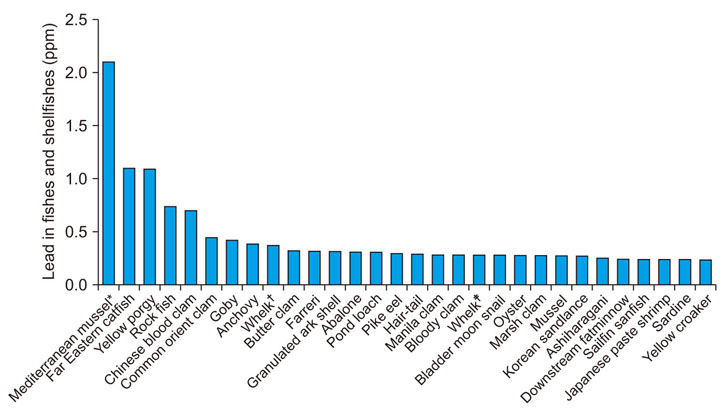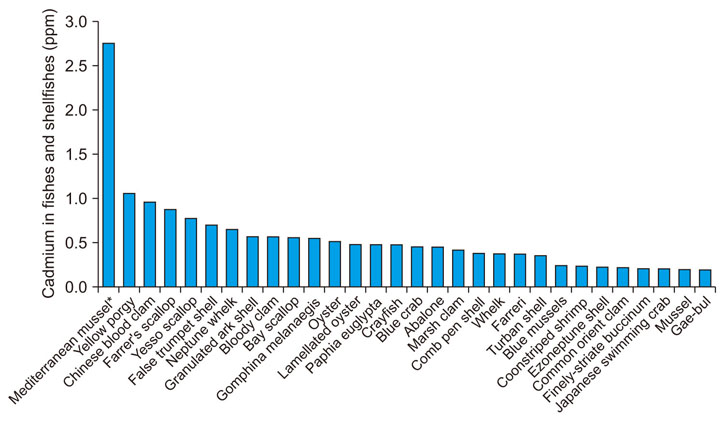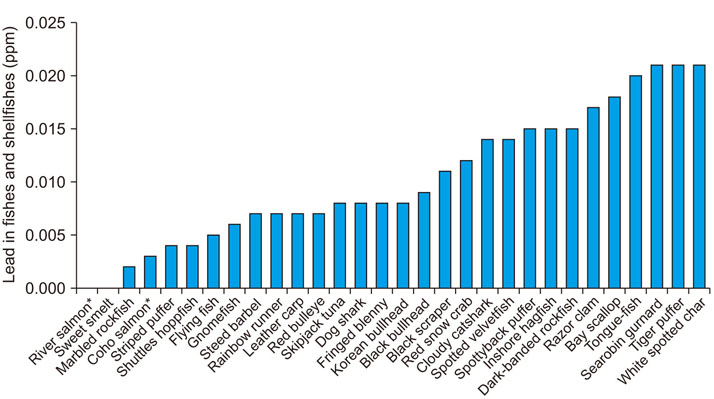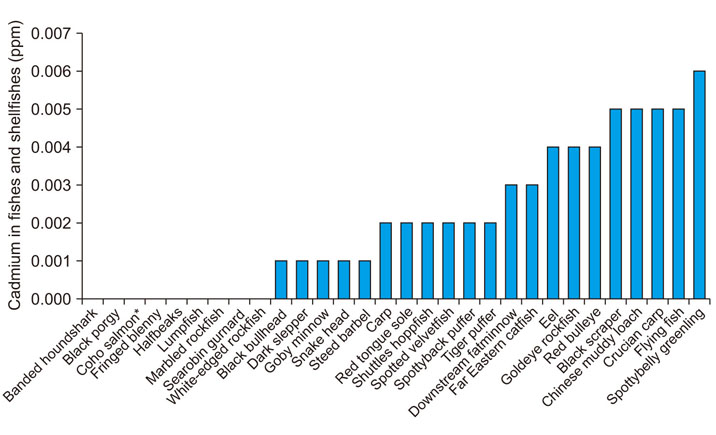Ewha Med J.
2018 Jan;41(1):1-7. 10.12771/emj.2018.41.1.1.
Systematic Review of Heavy Metal Concentrations in Fish and Shellfish in Korea
- Affiliations
-
- 1Department of Occupational and Environmental Medicine, Ewha Womans University College of Medicine, Seoul, Korea. eunheeha@naver.com
- 2Seoul Metropolitan Government Research Institute of Public Health and Environment, Seoul, Korea.
- KMID: 2403016
- DOI: http://doi.org/10.12771/emj.2018.41.1.1
Abstract
OBJECTIVES
Heavy metals ingested through the consumption of aquatic products can accumulate in the human body over the long-term and cause various health problems. This study aims to present comprehensive data on the amount of heavy metals found in fish and shellfish in Korea using a systematic review of studies that report on that issue.
METHODS
The study used the following databases: PubMed, Korean Studies Information Service System, and Research Information Sharing Service. The search terms for PubMed included fish OR shellfish OR seafood AND mercury OR cadmium OR lead OR heavy metal AND Korea. The search terms for Korean Studies Information Service System and Research Information Sharing Service included eoryu sueun, eoryu kadeumyum, eoryu nab, eoryu jung-geumsog, paeryu sueun, paeryu kadeumyum, paeryu nab, paeryu jung-geumsog, eopaeryu sueun, eopaeryu kadeumyum, eopaeryu nab, and eopaeryu jung-geumsog.
RESULTS
A total of 32 articles were selected for review. The total mercury, lead, and cadmium concentrations in fish and shellfish reported in each of the articles are summarized, as are the species of fish and shellfish with relatively high concentrations of heavy metals. Total mercury concentrations tended to be higher in predatory fish species, such as sharks, billfishes, and tuna, while lead and cadmium concentrations tended to be higher in shellfish.
CONCLUSION
This paper is the first to report a comprehensive summary of the concentrations of heavy metals in fish and shellfish. This data could be used as evidence to protect Koreans from exposure to heavy metals due to the consumption of highly polluted aquatic products.
Keyword
MeSH Terms
Figure
Reference
-
1. Castro-Gonzalez MI, Mendez-Armenta M. Heavy metals: implications associated to fish consumption. Environ Toxicol Pharmacol. 2008; 26:263–271.2. Singh R, Gautam N, Mishra A, Gupta R. Heavy metals and living systems: an overview. Indian J Pharmacol. 2011; 43:246–253.
Article3. Zahir F, Rizwi SJ, Haq SK, Khan RH. Low dose mercury toxicity and human health. Environ Toxicol Pharmacol. 2005; 20:351–360.
Article4. Needleman HL, Schell A, Bellinger D, Leviton A, Allred EN. The long-term effects of exposure to low doses of lead in childhood. An 11-year follow-up report. N Engl J Med. 1990; 322:83–88.5. Satarug S, Moore MR. Adverse health effects of chronic exposure to low-level cadmium in foodstuffs and cigarette smoke. Environ Health Perspect. 2004; 112:1099–1103.
Article6. Hwang YO, Park SG. Contents of heavy metals in marine fishes, sold in Seoul. Anal Sci Technol. 2006; 19:342–351.7. Park K, Mozaffarian D. Omega-3 fatty acids, mercury, and selenium in fish and the risk of cardiovascular diseases. Curr Atheroscler Rep. 2010; 12:414–422.
Article8. Ha GJ. A study on the heavy metal content in fishes and shellfishes of Gyeongsangnam-do coastal area. Changwon: Changwon National University;2004.9. Kim HY, Kim JC, Kim SY, Lee JH, Jang YM, Lee MS, et al. Monitoring of heavy metals in fishes in Korea: As, Cd, Cu, Pb, Mn, Zn, Total Hg. Korean J Food Sci Technol. 2007; 39:353–359.10. Kang SH, Lee MJ, Kim JK, Jung YJ, Hur ES, Cho YS, et al. Contents of total mercury and methylmercury in deep-sea fish, tuna, billfish and fishery products. J Food Hyg Saf. 2017; 32:42–49.
Article11. Choi WS, Yoon MC, Jo MR, Kwon JY, Son KT, Kim JH, et al. Total mercury content and risk assessment of farmed fish tissues. Korean J Fish Aquat Sci. 2016; 49:7–12.
Article12. Kim SJ, Lee HK, Badejo AC, Lee WC, Moon HB. Species-specific accumulation of methyl and total mercury in sharks from offshore and coastal waters of Korea. Mar Pollut Bull. 2016; 102:210–215.
Article13. Jo M, Kim K, Jo M, Kwon J, Son K, Lee H, et al. Mercury contamination and risk evaluation in commonly consumed fishes as affected by habitat. Korean J Fish Aquat Sci. 2015; 48:621–630.
Article14. Yang HR, Kim NY, Hwang LH, Park JS, Kim JH. Mercury contamination and exposure assessment of fishery products in Korea. Food Addit Contam Part B Surveill. 2015; 8:44–49.
Article15. Kim JA, Yuk DH, Park YA, Choi HJ, Kim YC, Kim MS. A study on total mercury and methylmercury in commercial tuna, billfish, and deep-sea fish. Korean J Food Sci Technol. 2013; 45:376–381.16. Choi H, Park SK, Kim M. Risk assessment of mercury through food intake for Korean population. Korean J Food Sci Technol. 2012; 44:106–113.
Article17. Kim CK, Lee TW, Lee KT, Lee JH, Lee CB. Nationwide monitoring of mercury in wild and farmed fish from fresh and coastal waters of Korea. Chemosphere. 2012; 89:1360–1368.
Article18. Park JS, Jung SY, Son YJ, Choi SJ, Kim MS, Kim JG, et al. Total mercury, methylmercury and ethylmercury in marine fish and marine fishery products sold in Seoul, Korea. Food Addit Contam Part B Surveill. 2011; 4:268–274.
Article19. Moon HB, Kim SJ, Park H, Jung YS, Lee S, Kim YH, et al. Exposure assessment for methyl and total mercury from seafood consumption in Korea, 2005 to 2008. J Environ Monit. 2011; 13:2400–2405.
Article20. Byeon MS, Lee JY, Park JJ, Shin SK, Han JS, Kim YH. Study on mercury concentrations of freshwater fish from lake An-dong and its upper stream. Anal Sci Technol. 2010; 23:492–497.
Article21. Joo H, Noh MJ, Yoo JH, Jang YM, Park JS, Kang MH, et al. Monitoring total mercury and methylmercury in commonly consumed aquatic foods. Korean J Food Sci Technol. 2010; 42:269–276.22. Oh S, Kim MK, Yi SM, Zoh KD. Distributions of total mercury and methylmercury in surface sediments and fishes in Lake Shihwa, Korea. Sci Total Environ. 2010; 408:1059–1068.
Article23. Kim HY, Chung SY, Sho YS, Oh GS, Park S, Suh JH, et al. The study on the methylmercury analysis and the monitoring of total mercury and methylmercury in fish. Korean J Food Sci Technol. 2005; 37:882–888.24. Oh KS, Suh J, Park S, Paek OJ, Yoon HJ, Kim HY, et al. Mercury and methylmercury levels in marine fish species Korean retail markets. Food Sci Biotechnol. 2008; 17:819–823.25. Mok JS, Yoo HD, Kim PH, Yoon HD, Park YC, Lee TS, et al. Bioaccumulation of heavy metals in oysters from the southern coast of Korea: assessment of potential risk to human health. Bull Environ Contam Toxicol. 2015; 94:749–755.
Article26. Mok JS, Kwon JY, Son KT, Choi WS, Kang SR, Ha NY, et al. Contents and risk assessment of heavy metals in marine invertebrates from Korean coastal fish markets. J Food Prot. 2014; 77:1022–1030.
Article27. Jun JY, Xu XM, Jeong IH. Heavy metal contents of fish collected from the Korean coast of the East sea (Donghae). Korean J Fish Aquat Sci. 2007; 40:362–366.
Article28. Jeong JI, Min SS, Lee JS, In SW, Kim DW, Park YS, et al. A study on the analysis of harmful heavy metals in fishes and shellfishes from Korean coastal areas (II). Korean J Forensic Sci. 2003; 4:200–206.29. Kim JH, Lim CW, Kim PJ, Park JH. Heavy metals in shellfishes around the South coast of Korea. J Food Hyg Saf. 2003; 18:125–132.30. Kim M, Kim JS, Sho YS, Chung SY, Lee JO. The study on heavy metal contents in various foods. Korean J Food Sci Technol. 2003; 35:561–567.31. Ham HJ. Distribution of hazardous heavy metals (Hg, Cd and Pb) in fishery products, sold at Garak wholesale markets in Seoul. J Food Hyg Saf. 2002; 17:146–151.32. Sho YS, Kim J, Chung SY, Kim M, Hong MK. Trace metal contents in fishes and shellfishes and their safety evaluations. J Korean Soc Food Sci Nutr. 2000; 29:549–554.33. Kim YC, Han SH. A study on heavy metal contents of the fresh water fish, and the shellfish in Korean. J Food Hyg Saf. 1999; 14:305–318.34. Kim KH, Kim YJ, Heu MS, Kim JS. Contamination and risk assessment of lead and cadmium in commonly consumed fishes as affected by habitat. Korean J Fish Aquat Sci. 2016; 49:541–555.
Article35. Jeon MA, Kang JC, Lee JS. Contamination of heavy metal and alteration of reproductive and histological biomarker of Mytilus galloprovincialis in Gamak bay of the Southern coast of Korea. Korean J Malacol. 2013; 29:33–41.36. Mok JS, Lee KJ, Shim KB, Lee TS, Song KC, Kim JH. Contents of heavy metals in marine invertebrates from the Korean coast. J Korean Soc Food Sci Nutr. 2010; 39:894–901.
Article37. Mok JS, Shim KB, Cho MR, Lee TS, Kim JH. Contents of heavy metals in fishes from the Korean coasts. J Korean Soc Food Sci Nutr. 2009; 38:517–524.
Article38. Hong TK, Hahm TS. Heavy metal concentrations in sediments and shellfish from western coast (Seosan, Taean). J Environ Res. 1999; 2:107–117.39. Ahn BH, Shin HK. Fatty acid composition and content of omega-3 polyunsaturated fatty acids of major fishes caught in Korean seas. Korean J Food Sci Technol. 1987; 19:181–187.40. U.S. Department of Health & Human Services. The reports of the dietary guidelines advisory committee on dietary guidelines for Americans [Internet]. Washington (DC): U.S. Department of Health & Human Services;c2005. cited 2017 Nov 01. Available from: https://health.gov/dietaryguidelines/dga2005/report/.
- Full Text Links
- Actions
-
Cited
- CITED
-
- Close
- Share
- Similar articles
-
- Association of iron status and food intake with blood heavy metal concentrations in Korean adolescent girls and women: Based on the 2010~2011 Korea National Health and Nutrition Examination Survey
- Dietary interventions to reduce heavy metal exposure in antepartum and postpartum women: a systematic review
- Carcinogenic and non-carcinogenic risk assessment of consuming metal-laden wild mushrooms in Nigeria: Analyses from field based and systematic review studies
- Early immune response of neuronal cells (U87) to heavy metal Cd or Pb exposure
- Relationships of Lead, Mercury and Cadmium Levels with the Timing of Menarche among Korean Girls

